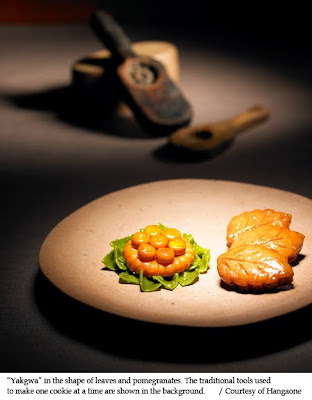
“Hangwa,” or the Korean confectionery industry is facing a new horizon as the sweets are making their way into peoples daily lives, not limited to the holidays but in everyday . Boosting the nutritional value and upgrading the packaging, many manufacturers are aiming to make it a global treat.
Hangwa in History
Now available at cafes and tea houses, hangwa still has a long way to go to match its glorious past. The origin of the Korean delights can be traced back to the Three-Kingdom Period (57 B.C.-A.D. 688); there are accounts of royalty eating various types of hangwa during ceremonies in “Samguk Yusa,” a historical tome that compiled numerous texts from the era.

Its heyday started in the Goryeo Kingdom (936-1392), when the Buddhist regime suppressed eating meat and the production of grains increased. But things got out of the hand — a type of hangwa, “yuyakgwa,” which includes “yakgwa,” uses a significant amount of grains, oil and honey. The regime was wary that the ingredients would become scarce due to the popularity of the treats. Twice, kings — King Myeongjong in 1179 and King Myeongjeong in 1192 — had to issue decrees that banned the production of such goods and encouraged the people to eat snacks made with fruit.
The restrictions on hangwa continued in the Joseon Kingdom (1392-1910). According to “daejeonhoetong,” the last law code published in the era, commoners caught eating the confectionery on occasions other than weddings or ancestral rites were subjected to punishment of up to 80 “gonjang,” or lashes with a bamboo rod.

Art in sweets
Hangwa not only runs through the history of the peninsular in terms of popularity but also in appearance.
Modern-day yakgwa’s signature shape is round with a rippled edge. However, it used to come in a variety of designs including the shapes of fruits or even living things.

Each pattern signifies a wish; butterflies represent a happy marriage, bats bring fortune, and pine trees symbolize the beginning of a new year. One would print a lotus for harmony and a pomegranate for fertility.
Then, in the Joseon Kingdom, it was simplified into a sphere. However, the balls were not suitable for presenting at the table for ancestral rites. So it transformed into a cube. Eventually, the yakgwa was stylized to take its current shape.

The traditional process used engraved plates to make individual yakwa, but a modern plate can churn out multiple cookies.
“Dasik,” ground grain mixed with honey or sugar water, is the most stylish of all hangwa. Usually made with sesame, mung beans, or glutinous rice, its decoration represents the culinary trends in Korean history.

Sometimes Chinese characters that represent wealth and power are engraved on the snacks. Some have floral prints or geometrical shapes adorning the multi-colored sweets. The crossing lines also deliver messages. Designs that mimic a tortoise shell represent the desire for a long life. Patterns varied across the country to reflect geography; mountainous towns etched sun rays on their dasiks while beach villagers drew waves.
Currently, Yaksun Dasik is the only manufacturer that specializes in this type of hangwa. For more information, visit www.yaksun.com.

Make your own hangwa
If you want to make a batch of hangwa for your family for the Lunar New Year, make a trip to Hangaone in Pyeongchang-dong, Gyeonggi Provine. The first museum for hangwa was established by Kim Gyu-heun, a nationally recognized expert of yugwa and yakgwa in 2008. The classes walk you through the process. Yugwa making is the most difficult of all the Korean desserts. One must mix glutinous rice and flour to make the dough and let the mixture sit and ferment. This step makes the small pieces of dough expand when fried in oil. Then using sugar water or honey as glue, one can decorate yugwa using just about anything; different grains can dress the snack in colors and dried fruits like raisins or seeds can spice things up. Classes are offered throughout the week except on Mondays at 11a.m. and 2 p.m. Registration is available online. The class welcomes families and large groups.
For more serious learners, professional hangwa courses are available. A four-month course offered from May through August includes instruction about the history of the confectionary and technical training in its making. Two-month classes offered from April to October will introduce students to the basics of hangwa.
For more information, call 031-533-8121 or visit http://www.hangaone.com.
Source: The Korea Times, Wikipidia

No comments:
Post a Comment